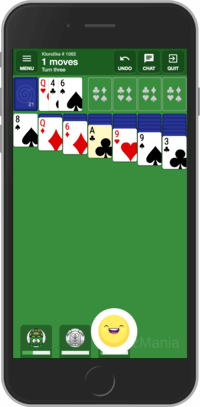Overview
Klondike is the standard version of solitaire where players must move all cards into four foundation piles, arranged into suits from Ace to King.
Multiplayer: All players (upto 12) are given the same tableau, and the winner is whoever finishes the game in the fewest moves.
Summary
- Sequences alternate colours
- Any length of sequence can be moved
- Only a King can be placed in an empty tableau slot
Presets
- Turn One: Turn cards from the draw pile one at a time
- Turn Two: Turn two cards at a time
- Turn Three: Turn three cards at a time
Play Multiplayer Solitaire Online
The Deck and the Deal
Solitaire uses a standard deck of cards. 28 cards are dealt out into seven tableaus (also known as cascades, columns of overlapping cards, with the bottom card available for play). These vary in length, from a single card and increasing by one until the last column of seven cards. Only the bottom card of each tableau is face up - all the other cards are dealt face down.
The remaining cards form the draw pile, located in the top left corner. A draw pile is the part of the deck set aside, face down, from which cards are drawn later.
The table also features four slots for foundation piles in the top right corner. These are slots for piles of cards running from the Ace to the King in sequence, one for each suit.
How to Play
The exposed bottom card of each tableau can be moved onto an exposed card of a value one higher and of the opposite colour to create a sequence. Whenever you pick up a card on Cardzmania, all the valid locations it can be moved to will be illuminated.
Existing sequences of any length can be moved to create longer sequences, provided the topmost card of the sequence being moved can be played onto the exposed bottom card of a tableau following the same rules as for single cards.
If a face down card becomes exposed at the bottom of a tableau, it is turned face up.
If a tableau is completely empty, only a King can be played into that slot.
Initially, only Aces can be moved into the foundation piles. Thereafter cards of the matching suit can be placed onto the Foundation Pile in ascending number order.
The Undo button in the bottom left corner will undo the previous move and can be used repeatedly to undo a whole sequence of moves.
Winning
The game ends when either all the cards have been moved into the foundation piles in order, or the player can find no way to proceed. The game is also scored based on how many moves the player took to solve it.
Variations
CardzMania supports several customizable rules and options so you can play Solitaire exactly how you like or how you grew up playing with your friends and family. In addition to the classic way of playing, we often have new creative options for you to try to spice up the game if you are interested in trying different spins for fun.
Draw Pile
There are three variations on how the draw pile can be used at CardzMania: Turn One, Turn Two and Turn Three.
In Turn One, the player can turn over the top card of the draw pile and choose whether to play it. Once the draw pile is exhausted, the discard pile can be turned over to become a fresh draw pile, by clicking on the empty Draw Pile slot.
In Turn Two, the player turns over the top two cards of the draw pile at once, but only the uppermost card can be played.
In Turn Three, the player turns over the top three cards of the draw pile at once, but only the uppermost card can be played.
Solitaire Basics
As the name implies, Solitaire games are typically games that one can play alone, however at CardzMania we also allow solitaire games to be played in parallel with multiple players. Solitaire begins by building a grid of cards called a Tableau. The Tableau, or Cascade, is a set of 7 piles of overlapping cards. The first pile has 1 card, the second pile has 2 cards, and so on. Only the bottom card in each pile is facing upward. The remaining deck forms the discard and draw piles. The goal of solitaire games is to move cards from the tableau, discard, and draw piles into four suited piles (called the foundations) in ascending order (Ace to King).
Foundation Piles
The Foundations are four piles (one for each suit) above the Tableau. Cards in a Foundation Pile must be in ascending order (starting with an Ace and ending with a King) and all be in the same suit. At the start of the game, the Foundations are empty.
Tableau
The Tableau, or Cascade, is a set of 7 piles of overlapping cards that the player creates at the start of a game. The first pile has 1 card, the second pile has 2 cards, and so on. Only the bottom card in each pile is facing upward. Cards can be transferred from the discard pile onto the Tableau if the faced up cards follow a descending order (King to Ace) and an alternate color pattern (red and black). When all of the faced up cards are transferred to another pile, the bottom card is flipped over. If a Tableau pile runs out, a new one can be started with a King.
Sequence
A group of cards arranged in numerical order. In Solitaire games, cards are typically played onto the next highest cards, such as Eights onto Nines, or Jacks onto Queens. Sequences of cards can often be moved together as if they were the highest value card in the sequence, but the rules governing this vary between games.
Cells
Slots into which a single card can be played and later played back onto the table. The number of cells in use can impact on other facets of the game.
Draw Pile
The Draw Pile, or Stock, is the remaining deck after the player creates the Tableau. It is set to the side and faces downward.
Discard Pile
Card Game Basics
A deck of cards consists of 52 cards, with 4 distinctive subgroups. Each of these subgroups is recognised by a symbol and are referred to as suits. They consist of Clubs, Spades, Hearts and Diamonds. Each suit contains 13 cards which, generally, are considered in this order, Ace (A), 2, 3, 4, 5, 6, 7, 8, 9, 10, Jacks (J), Queen (Q) and King (K). Some games include the two Jokers found in a standard deck but most games don't.
Feedback
Would like to discuss new features or variations for Solitaire? Need a custom rule? Have a question? Got a suggestion? Don't see a game you want to play? Please contact us by
email, facebook or twitter - we really value your feedback and love hearing from all of you!
This site uses cookies. By continuing to browse the site you are agreeing to our use of cookies.




